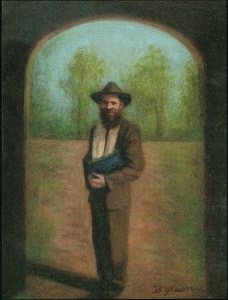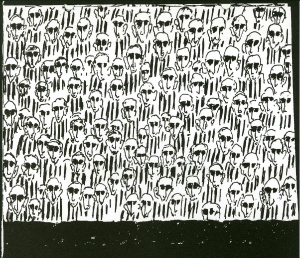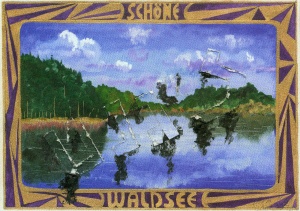Postcards
Art lies. An object depicted is not the actual thing, a person or relationship in art is but a fiction, an intellectual conceit that attempts to emotionally tempt us into a narrative insight. As much as art proclaims its purpose to be truth, it remains but a lie that is a means to an end.
Postcards can also lie. Innocently. “We’re having a great vacation, wish you were here…” And not so innocently. Once in the summer of 1944 postcards were used to lure Hungarian Jews to their deaths in Auschwitz. At the death camp new arrivals were forced to write postcards to friends and relatives back home. SS guards dictated the messages that reassured; “I am doing fine… I am working… Follow us here… We await your arrival.” The return address was from a fictitious place, Waldsee, easily confused with a German resort near the Swiss border. After the cards were completed most of these inmates were taken to the gas chambers. The lie of the Waldsee postcards was but a means to mass murder.
In 2004 an exhibition was organized in the 2B Gallery in Budapest. The curators, Andras and Laszlo Borocz invited an international array of artists to respond, each in their own manner, to the Waldsee postcards of almost sixty years earlier. The artworks could be in any medium whatsoever, only limited to the size of a standard postcard, five by seven inches. The New York exhibition of Waldsee, 1944 is co-curated by Laura Kruger, Andras Borocz and Robbin Ami Silverberg at the Hebrew Union College Museum. In their response seventy artists have used the Waldsee lie to open up truths about the Holocaust.
Each work demands close attention because of its inherent complexity. As art it can only be seen in relation to the original lie of Waldsee. Additionally almost every image is accompanied by a text panel written by the artist establishing context and intent. And finally the diminutive size draws us in, compelling us to look intensely, and finally, intimately.
Lynne Avadenka explores the geography of uncertainty with a 1928 Hebrew map of central Europe. Hungary has been ripped out. The opposite side of the card combines testimony about Waldsee from the Nuremberg trials in a dark swirl of lines that declares, “I am lost.” Intimate desperation is similarly evoked in Dorrit Bauer Title’s piece in which a burlap wrapped package is secured in wire that binds red stained lace and fragments of letters written by her grandparents before their deportation from Vienna. Fredrick Terna’s small painting, at first grimly abstract, then coming into focus as a spectral figure dashing to his death on the electric fence, testifies to his own experience that “time did not heal… flashbacks endure. This is the instant when I’m mailing my overdue postcard.”

Some artists have chosen a larger view asking for a critical distance. A simple image of a bearded Jew on his way to synagogue across a softly lit field tragically contrasts with the postcard text in English, at first reassuring, then illegible, concluding “eagerly await your arrival in the new home. Sincerely, Leah.” Barbara Green here utilizes stark contrasts to address the destruction of normalcy along with Hungarian Jewry.
Hanan Harchol, a grandchild of Vilna victims, recounts his frightening visit to Auschwitz one frozen winter day that summoned the story of a small child who was forced to stand outside, barefoot, as a punishment. This brutal cold has invaded his pen and ink drawing of close to a hundred cipher-like prisoners all sporting stripped uniforms and what seems, ironically, to be sunglasses. Postcard from the resort, Auschwitz. In a similar vein, Stephen Lack writes a postcard entitled Love in the Camps. The simple text asks a survivor innocently if there was any loving in the camps, any couples. At first dismissed, “Who could love… bones… you were just a bone covered with lice” then the respondent remembered a young couple, very much in love who managed to escape. Except that three days latter “we were all assemble to see them in the yard. HANG… yes there was love in the camps.”

The extent of the tragedy infuses every image, inevitably personalizing the crime with a quiet fury at the deception and cowardice inherent in the Waldsee postcards. Many images are elegiac, softly touching our hearts. Gyorgy Selmecz, a renowned composer and conductor, presents us with a sheet of music entitled Waldsee 2 composed by him. Five bars long, it is unintelligible to the uninitiated. And yet his text reminisces about music classes of his youth with a teacher who “taught us how the slow movement of the Schumann-quintet should sound… to help you survive the dead-end’s of forced labor. [How] the most horrid pain could be tolerated through op. 109, while op. 111 could help you to pass away with dignity.” The creative power of music in the face of bestiality is a postcard from sanity.

There are a number of works by familiar artists, Archie Rand, Natan Nuchi and this reviewer are included with signature works that challenge any easy understanding of the Waldsee lie. Debra Band specifically uses the lie as her subject. Her postcard is literally a postcard. A pleasant scene of a forested lake framed in an Art Deco border declares “Schone Waldsee,” beautiful Waldsee. And yet the peace and calm is undermined by a Yiddish word that seems to penetrate the image, “liganat,” lies. All the art, culture and skill are based on lies and here the lies were fatal. And we only understand this through the lies of this art.
Waldsee – 1944
Hebrew Union Collage – Jewish Institute of Religion Museum
One West 4th Street, New York, NY 10012